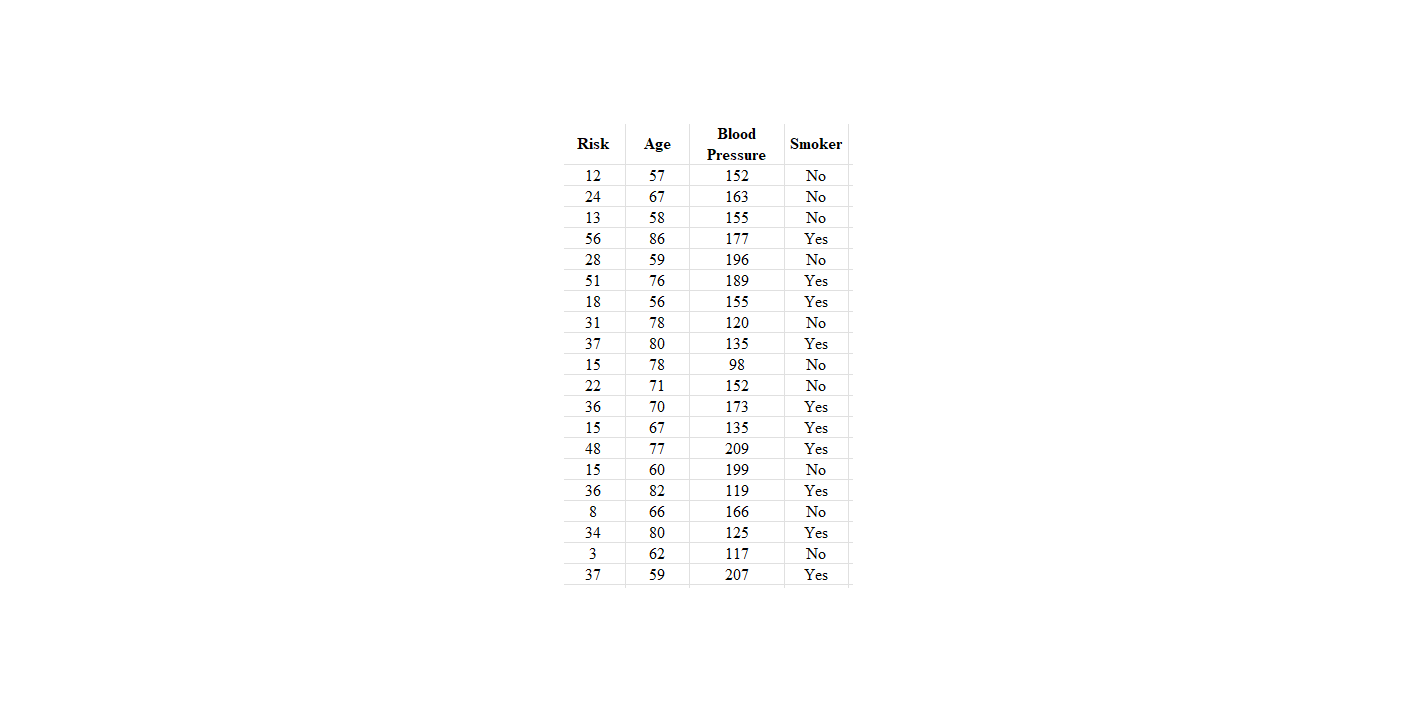

A recent 10-year study conducted by a research team at the Great Falls Medical School was conducted to assess how age, systolic blood pressure, and smoking relate to the risk of strokes. Assume that the following data are from a portion of this study. Risk is interpreted as the probability (times 100) that the patient will have a stroke over the next 10-year period. For the smoking variable, define a dummy variable with 1 indicating a smoker and 0 indicating a nonsmoker. The data set is available in the Excel file, Unit 5 Lab Data. Instructions: 1. Develop an estimated multiple regression equation that relates risk of a stroke to the person's age, systolic blood pressure, and whether the person is a smoker. 2. Is smoking a significant factor in the risk of a stroke? Explain. 3. What is the probability of a stroke over the next 10 years for Art Speen, a 68-year-old smoker who has a systolic blood pressure of 175 ? \begin{tabular}{|c|c|c|c|} \hline Risk & Age & Blood Pressure & Smoker \\ \hline 12 & 57 & 152 & No \\ \hline 24 & 67 & 163 & No \\ \hline 13 & 58 & 155 & No \\ \hline 56 & 86 & 177 & Yes \\ \hline 28 & 59 & 196 & No \\ \hline 51 & 76 & 189 & Yes \\ \hline 18 & 56 & 155 & Yes \\ \hline 31 & 78 & 120 & No \\ \hline 37 & 80 & 135 & Yes \\ \hline 15 & 78 & 98 & No \\ \hline 22 & 71 & 152 & No \\ \hline 36 & 70 & 173 & Yes \\ \hline 15 & 67 & 135 & Yes \\ \hline 48 & 77 & 209 & Yes \\ \hline 15 & 60 & 199 & No \\ \hline 36 & 82 & 119 & Yes \\ \hline 8 & 66 & 166 & No \\ \hline 34 & 80 & 125 & Yes \\ \hline 3 & 62 & 117 & No \\ \hline 37 & 59 & 207 & Yes \\ \hline \end{tabular} A recent 10-year study conducted by a research team at the Great Falls Medical School was conducted to assess how age, systolic blood pressure, and smoking relate to the risk of strokes. Assume that the following data are from a portion of this study. Risk is interpreted as the probability (times 100) that the patient will have a stroke over the next 10-year period. For the smoking variable, define a dummy variable with 1 indicating a smoker and 0 indicating a nonsmoker. The data set is available in the Excel file, Unit 5 Lab Data. Instructions: 1. Develop an estimated multiple regression equation that relates risk of a stroke to the person's age, systolic blood pressure, and whether the person is a smoker. 2. Is smoking a significant factor in the risk of a stroke? Explain. 3. What is the probability of a stroke over the next 10 years for Art Speen, a 68-year-old smoker who has a systolic blood pressure of 175 ? \begin{tabular}{|c|c|c|c|} \hline Risk & Age & Blood Pressure & Smoker \\ \hline 12 & 57 & 152 & No \\ \hline 24 & 67 & 163 & No \\ \hline 13 & 58 & 155 & No \\ \hline 56 & 86 & 177 & Yes \\ \hline 28 & 59 & 196 & No \\ \hline 51 & 76 & 189 & Yes \\ \hline 18 & 56 & 155 & Yes \\ \hline 31 & 78 & 120 & No \\ \hline 37 & 80 & 135 & Yes \\ \hline 15 & 78 & 98 & No \\ \hline 22 & 71 & 152 & No \\ \hline 36 & 70 & 173 & Yes \\ \hline 15 & 67 & 135 & Yes \\ \hline 48 & 77 & 209 & Yes \\ \hline 15 & 60 & 199 & No \\ \hline 36 & 82 & 119 & Yes \\ \hline 8 & 66 & 166 & No \\ \hline 34 & 80 & 125 & Yes \\ \hline 3 & 62 & 117 & No \\ \hline 37 & 59 & 207 & Yes \\ \hline \end{tabular}








